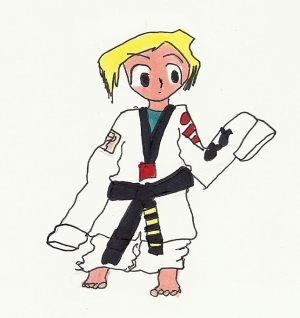Benefits of Children Taking Taekwondo
Visit most Taekwondo schools and you'll typically find some pint-sized students. Children aged four and up can benefit from Taekwondo training, depending on the philosophy of the school and instructor. Check out the school thoroughly before enrolling your child (more on checking out a school here), and know what questions to ask about the training your child will receive.
- Won’t my child use his (or her) skills aggressively, and get into more fights at school? A basic tenet of Taekwondo is that it must be used for self-defense only. However, don’t enroll your child before you ask the instructors their philosophies on self-defense and on dealing with fights and bullying. Watch one or two classes; if it seems to you that an instructor is more interested in teaching fighting rather than self-defense, it may not be a good school for your child.
It’s important to be involved with your child’s Taekwondo growth. Asking, “How was class?” is one thing, but asking about what he is learning or how she is being told to handle real-world situations can enlighten you as to what is really happening in the classes.
 Taekwondo Dreamer, By Kathryn Lichlyter |
- At what age should I start my child? Different schools will give different answers. Some start children as young as 4 and 5; others may suggest waiting until the child is 6 to 8 years old. Younger children learn faster, but, to get the benefit of the training, the child must have the mental skills to focus and concentrate on a task during the class time. |
You might ask that your child take one or two classes at the recommendation of the instructor, just to see how the child does. When my oldest child was four, she tried a class, and both the instructors and I agreed that she wasn't ready. However, eighteen months later it was a different story. At this writing, she is a blue belt.
- Is it safe for my child to spar? While accidents and injuries (more on that here) can happen, it's important to ask questions and take the instructor’s advice as to when your child is ready for sparring. This decision varies among dojangs. You must ALWAYS have your child use the correct sparring equipment; help him or her to put it on if necessary. This equipment is designed to absorb the impact of a kick or punch, and a good dojang requires it even for light contact practice. The instructor should also match up sparring partners by size and degree of skill.
I started completing in junior high school. My mother used to watch me with trepidation – one eye peeking through her hands – but a controlled hit to a chest protector will not hurt nearly as much as you might think! And your child may love competing.
- Can Taekwondo fix my child’s attitude problem? Some master instructors may advertise that they can "fix" your troubled child or youth. But you can’t expect a quick fix, or, actually, any fix that doesn’t involve you. Taekwondo instruction can help instill discipline, self-control, and courtesy. But you must not depend on the instructors alone; you must take responsibility as well. As one instructor put it, "I can help mold a student, but he must be here in class to mold." In other words, get your student to all classes. Make sure to set the example of self-control and courtesy for your child outside of class. Be supportive; this includes taking time for your child’s tests and other events. When your child shows positive results, both in Taekwondo and in life, give praise and congratulations. Only a joint effort can truly change a child or youth who has an attitude problem.
- My child suffers from ADD, ADHD, or another physical or mental challenge. How can Taekwondo help? These are case-by-case situations, so you need to discuss it in detail with the Taekwondo school instructor or master. Each child is different; each school is different. I have known instructors who have been able to take students of all abilities, limitations and challenges, and help them all learn and grow.
Before enrolling your child, however, ask questions. If the instructor provides references from previous students with similar challenges, be sure talk with the references. In addition, have your child participate in a few classes first with the instructor’s recommendation and approval. Many children with challenges benefit from Taekwondo. It is difficult to determine if yours will be successful or not without trying.
- My child wants to advance belts quickly. How can I find a school that does this? I cover what I call a "black belt factory" on another page. The desire to advance is not a bad thing, if done with control and the instructor’s approval. I have trained with students who are black belts at the age of 10, 11 or 12, many of whom are properly qualified. Unfortunately, there are children who graduate from a "black belt factory" and display an "I have my black belt" attitude, but who have no more discipline, focus or skills than a green belt – or even than their peers who are not taking Taekwondo.
If your child wants to advance quickly, be sure to get involved. Ask the instructors if he or she really is ready for testing. It is good for you to be familiar with the belt system and how promotion is accomplished (which we discuss here).
When we enrolled our children in Taekwondo classes, we told instructors that we did not want them to test before they were truly ready, even if they didn't move up with their peers. This has proven very beneficial. Although my children haven’t always liked it, they have learned more about truly mastering their skills and accomplishing their goals. They learn the techniques properly and completely before they test, and that means they benefit more from the training – and still enjoy themselves.

Are You A Parent of a Taekwondo Child?
We want to hear how Taekwondo has helped your child. Each case is different and each school is different. Can you highlight how your child has developed with his or her Taekwondo training? You can even upload a picture (as appropriate) to show your child how proud you are of them and post it for your friends and family to see!
Taekwondo Instructors and Schools: Link your school website to Taekwondo-guide.com as a resource for your students.